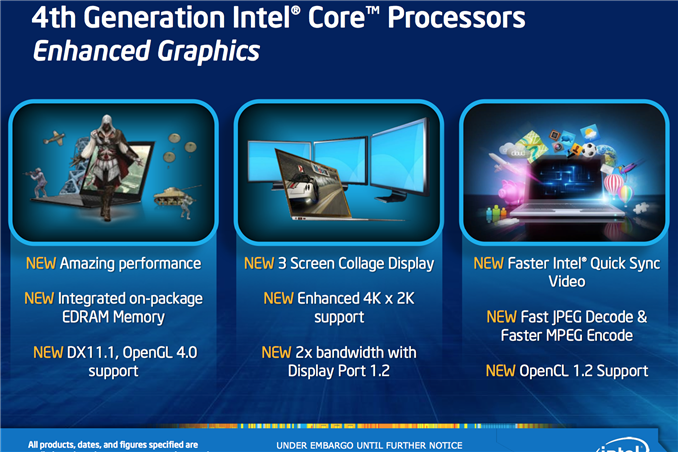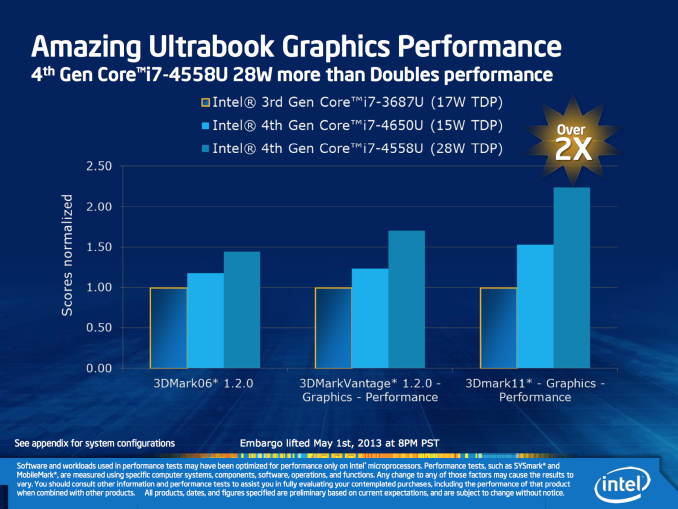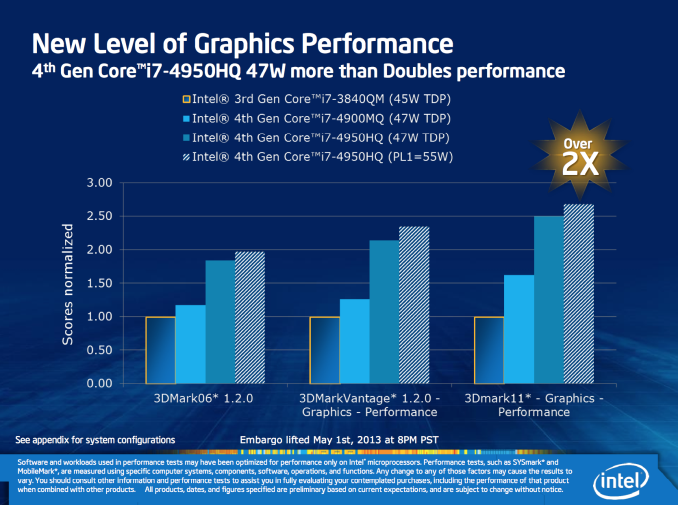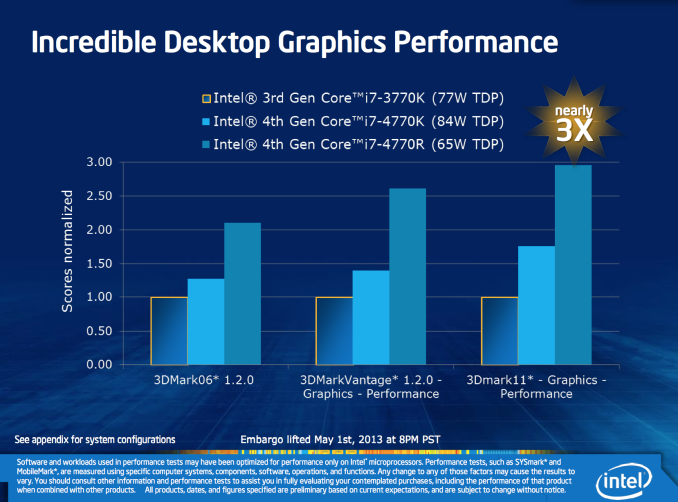Intel Iris & Iris Pro Graphics: Haswell GT3/GT3e Gets a Brand
by Anand Lal Shimpi on May 1, 2013 11:00 PM EST
We’ve known for a while that Intel’s Haswell processor would continue to drive GPU performance in a significant way. With Haswell, Intel will offer a higher end graphics configuration with more execution resources than before (GT3) as well as an even higher end offering that pairs this GPU with 128MB of embedded DRAM on the CPU package (GT3e). Intel’s performance target for the highest end configuration (GT3e) is designed to go up against NVIDIA’s GeForce GT 650M, a performance target it will hit and miss depending on the benchmark.
Regardless of whether or not it wins every benchmark against the GT 650M, the fact that an Intel made GPU can be talked about in the same sentence as a performance mainstream part from NVIDIA is a big step forward. Under no circumstances could Intel compete with NVIDIA on performance and still do so under the Intel HD Graphics brand. Haswell is the beginning of a new era for Intel. The company is no longer a CPU company forced into graphics, but with Haswell Intel begins its life as a GPU company as well. As a GPU company, Intel needs a strong GPU brand. AMD has Radeon, NVIDIA has GeForce, and now Intel has Iris.
The brand is a nod to a long forgotten history of 3D graphics, as well as an obvious reference to the fact that GPUs are used for very visual purposes. Before OpenGL was well, open, it was a project known as IrisGL.
Intel is doing the right thing with Iris and only using it to refer to its absolute best graphics options. Intel HD Graphics will remain, and will refer to all GT1/GT2 and some GT3 configurations with Haswell. Iris and Iris Pro will be used to refer to high end GT3 and GT3e configurations:
Anything with GT3e will have Intel’s Iris Pro 5200 graphics, while 28W SKUs with GT3 will have vanilla Iris 5100 (non-Pro). Any 15W SKUs with GT3 will be HD Graphics 5000, and GT2/GT1 parts will also be identified as Intel HD Graphics.
We know what makes Iris Pro special (128MB of eDRAM), but it appears that the main difference between Iris 5100 and HD 5000 is max GPU clock speed. Intel wants Iris associated with performance, which is a very good thing. Having Iris reach down into non-GT3e parts as well is a bit unsettling but at least GT3e gets the Pro designation.
Intel claims Iris/Iris Pro will deliver up to 2x better performance than Intel’s HD 4000 graphics in notebooks, and it’s using 3DMark11 to validate that claim:
Although Ultrabooks (now 15W) won’t get full blown Iris performance, they should still see a healthy increase in GPU performance compared to where they are today (50% improvement in 3DMark) at a lower TDP. The move to a full speed GT3 part (Iris) should more than double performance in 3DMark. Also worth noting is the fact that we now have a 28W ULT part (i7-4558U). This is a part designed for larger Ultrabooks (14/15"+) that would otherwise have a low end discrete GPU.
Iris Pro will be exclusive to quad-core parts, and the advantage there grows to 2.5x in 3DMark11. There's a slight increase in processor TDP here, but obviously much better performance. That last bar is with the i7-4950HQ running with its TDP set to 55W (cTDP up).
BGA (non-socketed) desktops will also have the option of using Iris Pro if you get an R-series SKU. The performance gains there over Intel HD 4000 are even more impressive thanks to the additional TDP headroom:
QuickSync performance will also improve as a function of increased number of EUs. There’s also DX11.1, OpenCL 1.2, OpenGL 4.0 and 4Kx2K support.
This is really the beginning of a new era. Intel isn't talking specifics about power savings here, but that's really where Iris and Iris Pro will shine. The fact that performance will finally be reasonable enough to actually play games is just icing on the cake. Kicking discrete GPUs out of non-gaming focused notebooks and replacing them with Iris Pro parts should keep performance high while significantly reducing power consumption.
With Iris Intel is finally committed to graphics, and that's a very good thing.















104 Comments
View All Comments
jeffkibuule - Wednesday, May 1, 2013 - link
If performance really is as claimed, I wonder if Apple will drop dedicated graphics in the 15" Retina MacBook Pro and just stick with Intel... Or we could even see a hypothetical 15" MacBook Air.ISwearImCool - Thursday, May 2, 2013 - link
They might, but then they have extra space in the chassis of the laptop. Apple gets a lot of milage out of their designs so I expect it to stay.This should be huge for the 15 inch retina pro though. Its scrolling is currently less smooth than the 13 because it uses onboard graphics unless doing something intense.
Death666Angel - Thursday, May 2, 2013 - link
Huh? The 13" one only has the integrated graphics to work with as well. And it has the slower CPUs as well, with slower max turbo clocks for the iGPU too. Your explanation makes no sense.Maybe the 26.5% increased pixel count is the reason for the bad performance.
akdj - Sunday, May 5, 2013 - link
"This should be huge for the 15 inch retina pro though. Its scrolling is currently less smooth than the 13 because it uses onboard graphics unless doing something intense."Not true at all. There aren't any scrolling issues due to hardware, never was. Poorly coded sites...and non HiDPI ready sites exhibited some scrolling lag...initially. 10.8.2 helped a LOT. 10.8.3 even more significantly. As well, Ars, Facebook, TechCrunch...and a few other media-rich, content heavy, extremely 'over busy' sites have helped a ton with their coding. The Intel 4000 is actually a damn good card and easily able to run HiDPI monitors like Apple's own cinema displays without issue. Not to mention, the 15" includes a discrete, over clocked 650m. If ever you're scrolling/visiting a site that exhibits 'lag', you can easily enable your discrete card to alleviate any challenges. A lot of this has to do with the pixel doubling as well...which you can see is using CPU power (if you're running iStat...or any number of apps that allow you to gauge processor real time power) and the rMBP is more than equipped to handle this upscaling. Again...the updates to ML, coding pros working on busy sites...and the impact that more HiDPI monitors have on the Internet will be the kick in the rear some of these lazy sites need to update their code to perform better.
The entire 'lag' thing with rMBPs has been blown so SO far out of proportion, it's silly. I know when Anand tested the rMBP initially it was on Lion. 10.7. That is where there were issues. 10.8 helped a lot...and the point updates, as well as the software industry over the past year has helped significantly the early speed bumps the rMBP experienced. Non-optimized apps and software as well as poorly coded websites and low resolution, non-vector imaging. So much has changed over the past 10 months since its release, it's crazy! Very exciting actually, as hopefully these high resolution monitors are ubiquitous sooner than later. Rest assured though...as a rMBP owner (we've got a pair that replaced our 17" 2011 models for primary computers as our business is mobile), it really makes me sad that so much misinformation is still spread on the rMBP. Even as a windows fan, you should be 'rooting' for this evolutionary display update. When using the display for long periods of time, your eyes will thank you!
seapeople - Friday, May 10, 2013 - link
So you're telling me that if I walk to Best Buy, set the rMBP to 1920x1200 equivalent, open up AnandTech, zoom in so the text covers most of the screen, and start scrolling around, it's NOT going to lag like crazy? As of a few weeks ago, significant lag was still there...firex123 - Thursday, May 2, 2013 - link
how would an AMD Temash/Jaguar roughly compare to a tablet Haswell? Objective views pls ;Dwhatthehey - Thursday, May 2, 2013 - link
Ugh... that would be a blowout, at least in performance, for Haswell. The current E-series APUs are only slightly better than Atom garbage! Oh, they're faster than ARM as well in most cases, but I think even some of the ARM GPU configurations beat AMD's E-series parts. Temash/Jaguar go quad-core, but that doesn't do anything for lightly threaded workloads, which are still very common.kyuu - Thursday, May 2, 2013 - link
Obviously Haswell would beat it... Jaguar are low power CPU cores like Atom (although superior). Comparing Jaguar cores to Haswell is inane.Stryfe34 - Thursday, May 2, 2013 - link
The 4770K is the top of the line desktop processor but yet the 4770R has the highest increase in the GPU. Based on what I've been reading the "R" designator mean that the CPU is embedded to the motherboard so no upgrades so I'm not in the market for it. You'd think they would add that priority to the 4770K also.beginner99 - Thursday, May 2, 2013 - link
Why? The 4770K is for overclocking and overclockers usually don't run with an iGPU but have a dedicated GPU anyway. Personally the would rather add 2-4 more cores to it and remove the iGPU completely.